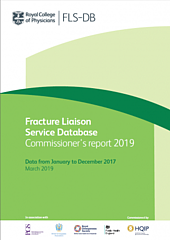 by Ellie Davies, Acting Project Manager, Falls and Fragility Fracture Audit Programme (FFFAP)
by Ellie Davies, Acting Project Manager, Falls and Fragility Fracture Audit Programme (FFFAP)
The challenge:
520,000 cases of fragility fracture occur every year amongst those (primarily over-50s) suffering with the bone-weakening disease known as osteoporosis. That is 520,000 broken bones caused by as little as slipping in the shower, stepping off a curb even. This is not only a huge economic burden on the NHS, approximately £5.25 billion, but an epidemic that has lasting physical and emotional repercussions for sufferers. It is upsetting to learn that 42% of older people say that osteoporosis has made them feel more socially isolated.
And it’s going to get worse. For as life expectancy steadily increases, it is estimated that there will be 25% more fragility fractures by 2030, and with that a 30% rise in healthcare costs that the NHS is simply not equipped to meet. A sobering prospect yes, but a crucial reminder nonetheless that now is the time to target improvement.
The solution:
Of course, eradicating the occurrence of fragility fractures altogether is the ultimate goal. However, given that any such fracture approximately doubles the risk of another, most likely within two years, focusing on secondary prevention is an effective starting point. Rapid assessment and timely treatment post index (first) fracture could avoid thousands of secondary cases.
Fracture Liaison Services (FLS): what are they and why are they so important?
A fracture liaison service (FLS) is an NHS service which aims to reduce the risk of subsequent fractures by systematically identifying, treating and referring all eligible patients aged 50 and over who have suffered a fragility fracture to appropriate services. A FLS is a proven approach, recommended by the Department of Health, for targeting these high-risk groups and improving secondary fracture prevention.
Fracture Liaison Service Database (FLS-DB): Our mission
 According to the Fracture Liaison Service Database: Commissioner’s report 2019, there are significantly fewer fracture liaison services (FLSs) available for older patients in some parts of England and Wales than others. The Fracture Liaison Service Database (FLS-DB) is not only working towards improving the care provided by existing services but making these preventative services available more widely and avoid approximately 50,000 life-altering fractures in the process.
According to the Fracture Liaison Service Database: Commissioner’s report 2019, there are significantly fewer fracture liaison services (FLSs) available for older patients in some parts of England and Wales than others. The Fracture Liaison Service Database (FLS-DB) is not only working towards improving the care provided by existing services but making these preventative services available more widely and avoid approximately 50,000 life-altering fractures in the process.
 Dr Kassim Javaid, RCP clinical lead for the FLS-DB said “Those suffering broken bones are often the most vulnerable in society and it is unacceptable that such variation exists in service accessibility depending on where in the country they live. Fracture liaison services are proven to reduce the risk of experiencing further fractures, reducing the impact on older patients, and save the NHS millions of pounds. I implore all Clinical Commissioning Groups to ensure that FLSs are commissioned in their areas so that millions of older people receive the care they deserve.”
Dr Kassim Javaid, RCP clinical lead for the FLS-DB said “Those suffering broken bones are often the most vulnerable in society and it is unacceptable that such variation exists in service accessibility depending on where in the country they live. Fracture liaison services are proven to reduce the risk of experiencing further fractures, reducing the impact on older patients, and save the NHS millions of pounds. I implore all Clinical Commissioning Groups to ensure that FLSs are commissioned in their areas so that millions of older people receive the care they deserve.”
What can you do?
- Watch and share our short animation with information about fragility fractures and the care that should be provided
- Read and share our guide to strong bones after 50 to help reduce the occurrence of fragility fractures
- Find out about the data available for healthcare professionals and academic institutions for research and analysis
- Follow us on twitter @RCP_FFFAP to find out more about the FLS-DB and other related audits.

